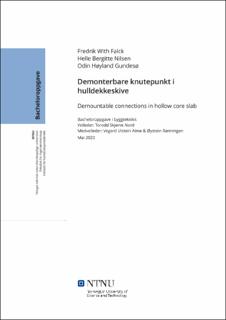| dc.contributor.advisor | Nord, Torodd Skjerve | |
| dc.contributor.advisor | Ulstein, Vegard Alme | |
| dc.contributor.advisor | Rønningen, Øystein | |
| dc.contributor.author | Falck, Fredrik With | |
| dc.contributor.author | Nilsen, Helle Bergitte | |
| dc.contributor.author | Gundesø, Odin Høyland | |
| dc.date.accessioned | 2022-07-19T17:22:29Z | |
| dc.date.available | 2022-07-19T17:22:29Z | |
| dc.date.issued | 2022 | |
| dc.identifier | no.ntnu:inspera:112300464:112301113 | |
| dc.identifier.uri | https://hdl.handle.net/11250/3007031 | |
| dc.description.abstract | Forutsetningen for prosjektering av bygg i dag er at de skal rives ved endt levetid, som gir lite rom for gjenbruk. I kombinasjon med dagens klimafokus er målet nå mer rettet mot bygg som ved endt levetid kan skape gode donorbygg for fremtiden. Dette gir grunnlaget for oppgavens formål med å utvikle et demonterbart knutepunkt. Etter ønske fra oppdragsgiver skal det utvikles knutepunkt mellom hulldekke og hyllebjelke. Videre skal oppgaven undersøke utfordringer knyttet til demontering av dagens løsninger, finne knutepunktets kapasitet og argumentere for bruksmulighetene av utviklet konsept. Problemstillingen tar utgangspunkt i innovasjonsprosjektet Sirkulære nybygg og ble skrevet i samarbeid med Spenncon.
Metoden baseres på litteraturstudie, innhenting av data for dimensjonering og utvikling av knutepunkt. Data vil hentes fra et eksempel som tar for seg et klassisk elementbygg med stive vertikale og horisontale skiver påkjent av seismiske laster.
Resultatet viser knutepunktets utforming, hvor krefter skal overføres med dybelskjær i kombinasjon med skjærfriksjon. Fuger mellom hulldekkene støpes ut, mens endefugene holdes åpne. Bjelke dekke forbindelsen er satt sammen av hyllevarer og er designet for demontering. For å kunne demonteres senere smøres sidekant av dekkene, samt deler av dybelforbindelsen med ett slippmiddel som forhindrer heft. Det konkluderes med at utviklet konsept er praktisk gjennomførbart og har tilstrekkelig kapasitet. Det er økonomisk konkurransedyktig sammenlignet med demontering av gamle hulldekker. Videre arbeid kreves for å bekrefte resultatene. | |
| dc.description.abstract | The prerequisite for designing buildings today is that by the end of their life service, they shall be demolished, which leaves little room for re-use. In combination with the current climate focus, the aim is now set towards creating buildings that by the end of their life service will serve as good donor buildings. This provides the foundation for the reports intention of developing a demountable connection. At the request of the employer the connection between hollow core slab and ledged beam shall be developed. Furthermore, the report will examine the challenges related to dismantling current connections, find the connections’ capacity and argue the possibilities of use for the developed concept. The thesis question comes from the innovation project “Sirkulære nybygg” and is written in collaboration with Spenncon.
The method is based on a literature study, collection of data for dimensioning and development of connections. The data will be retrieved from an example containing a classic concrete element building with rigid vertical and horizontal slabs stressed by seismic loads.
The result shows the design of the connection, where the shear forces shall be transferred by dowel action as well as shear friction. Joints between the hollow core slabs are cast out, while the end joint is not. The connection is assembled by off-the-shelf items and is designed for disassembly. To enable dismantling, the edges and the dowel connection will be lubricated with a release agent that disables adhesion. The report concludes by the concept being practically executable and has sufficient capacity. It is economically competitive compared to demolition of old hollow core slabs. Further research is required to confirm the results. | |
| dc.language | nob | |
| dc.publisher | NTNU | |
| dc.title | Demonterbare knutepunkt i hulldekkeskive | |
| dc.type | Bachelor thesis | |
